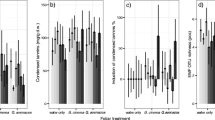Abstract
Differences in susceptibility to infestation by spruce spider mite of 3 investigated spruce species (Picea glauca ‘Conica’, P. pungens and P. omorika) may be due to features of anatomical and morphological structure of needles. In P. omorika, showing some resistance to the spruce spider mite, we noted lamellar structure of epidermal cell walls and extensive supporting tissues (hypodermis and sclerenchyma fibres) at the whole circumference of the needle.
Similar content being viewed by others
References
Bielak B. 1979. Wpływ wybranych ro lin z rodziny Rosaceae na biologi prz dziorka owocowca Panonychus ulmi (Koch). [The effect of some plant species of Rosaceae on biology of the fruit-tree spider mite]. PhD thesis, SGGW Warsaw.
Bielak B., D browski Z.T. 1985. Techniques and methods used in studies of resistance to Panonychus ulmi in apple varieties. Insect Sci. Appl. 6(3): 473–478.
Czajkowska B., Kiełkiewicz M. 2002. Linden-leaf morphology and the host-plant susceptibility to Eotetranychus tiliarium (Hermann) (Acarida: Tetranychidae). In: Acarid Phylogeny and Evolution. Adaptations in mites and ticks. Bernini F., Nannelli R., Nuzzaci G., de Lillo E. (red.). Kluwer Academic Publishers. Netherlands: 435–440.
Czajkowska B., Kiełkiewicz M., Puchalska E. 2003. Population parameters as an inicator of susceptibility of ornamental coniferous plants to spruce spider mite (Oligonychus ununguis Jacobi). Journal of Plant Protection Research 43(2): 155–162.
Czajkowska B., Przygoda E., Kiełkiewicz M. 2001. Zagro enie ozdobnych ro lin iglastych przez prz dziorka sosnowca (Oligonychus ununguis Jacobi, Acarida: Tetranychidae) w szkółkach na terenie Polski. [Threat of ornamental coniferous plants by the spruce spider mite (Oligonychus ununguis Jacobi, Acarida: Tetranychidae) in nurseries in Poland]. Progress in Plant Protection/Post py w Ochronie Ro lin 41(2): 532–535.
D browski Z.T., Rodriguez J.G. 1971F. Studies on resistance of strawberries to mites. 3. Preference and nonpreference responses of Tetranychus urticae and T. turkestani to essential oils of foliage. J. Econ. Entomol. 64(2): 387–391.
Fenilli R., Flechtmann C.H.W. 1990. Mites of Araucaria angustifolia in Lages, Santa Catarina. Ana. Esc. Super. Agri. ‘Luiz de Queiroz’ 47(1): 243–250.
Gutierrez J., Kreiter S., Brian F., Cotton D. 1986. Les acariens, ravageurs mal connus du cypres. Phytoma 376: 47–48.
Gutierrez J., Schicha E. 1983. The spider mite family Teranychidae (Acari) in New South Wales. Int. J. Acarol. 9(3): 99–116.
Kiełkiewicz M. 1999. Ultrastructural cell modification in tomato (Lycopersicon esculentum) leaf tissue in response to the carmine spider mite (Tetranychus cinnabarinus) feeding. In: Ecology and Evolution of the Acari. Bruin J., van der Geest L.P.S., Sabelis M.W. (red). Kluwer Academic Publishers, Netherlands: 603–615.
Kiełkiewicz M., Puchalska E., Czajkowska B. In press. Host spruce quality and its effect on spruce spider mite (Oligonychus ununguis Jacobi, Acari: Tetranychidae) Bionomy. IOBC Białowie a.
Kiełkiewicz M., Van De Vrie M. 1983. Histological studies on strawberry leaves damaged by the two-spotted spider mite (Tetranychus urticae): Some aspects of plant self defence. Med. Fac. Landbouw. R’ksuniv. Gent 48(2): 235–245.
Larson K.C., Berry R.E. 1984. Influence of peppermint phenolics and monoterpenes on twospotted spider mite (Acari: Tetranychidae). Environ. Entomol. 13: 282–285.
Löyttyniemi K. 1970. Zur Biologie der Nadelholzspinnmilbe (Oligonychus ununguis (Jacobi), Acarida, Tetranychidae) in Finnland. Acta Entomol. Fenn. 27: 1–64.
Muller W.C., Greenwood A.D. 1978. The ultrastructure of phenolic-storing cells fixed with caffeine. J. Exp. Bot. 29(110): 757–764.
Przygoda E. 2001. The occurrence of spruce spider mite (Oligonychus ununguis Jacobi) on ornamental coniferous plants in botanical gardens in Poland. Annals of Warsaw Agricultural University-SGGW Horticulture, Landscape Architecture 22: 23–29.
Przygoda E., Czajkowska B. 2001. Zasiedlanie przez Oligonychus ununguis (Jacobi) ozdobnych ro lin iglastych w warunkach miejskich. [Infestation of ornamental coniferous plants by Oligonychus ununguis (Jacobi) under town environment]. Barczak T., Indykiewicz P., Kaczorowski G. (red.) Bioró norodno i ekologia populacji zwierz cych w rodowiskach zurbanizowanych, Wyd. NICE Bydgoszcz: 114–120.
Reynolds E.S. 1963. The use of lead citrate at high pH as electron-opaque stain for electron microscopy. J. Cell. Biol. 17: 208–213.
Richmond D.S., Shetlar D.J. 1996. Eclosion time and spatial distribution of overwintering spruce spider mite (Acari: Tetranychidae) eggs on Colorado spruce. J. Econ. Entomol. 89(2):447–452.
Sun Xg., Zhou Cg., Zhang Xd., Liu Ym., Mi Xm. 1995. A study on the diapause of Oligonychus ununguis (Jacobi). Acta Entomol. Sin. 38(3): 305–311.
Tomczyk A.; Kiełkiewicz M., Kropczy ska D. 1988. Mechanizmy odporno ci ro lin na prz dziorki. [Mechanisms of plant resistance to spider mites]. Prace Instytutu Sadownictwa i Kwiaciarstwa. Seria C 1–2: 34–36.
Wermelinger B., Oertli J.J., Delucchi V. 1985. Effect of host plant nitrogen fertilization on the biology of the two-spotted spider mite, Tetranychus urticae. Entomol. Exp. Appl. 38: 23–28.
Wilhelmsen L.R. 1996. Types of yellow flecks on needles of Norway spruce (Picea abies) and Scots pine (Pinus sylvestris) and their origin. Rapport fra Skogforsk No. 4, 21p.
Yuksel B., Ulusoy H. 2000. Harmfulness and control of Oligonychus ununguis Jacobi in conifer forest in eastern Black Sea region of Turkey. Orman Muhendisligi 36(9): 28–31.
Author information
Authors and Affiliations
Corresponding author
Rights and permissions
About this article
Cite this article
Puchalska, E., Tykarska, T. & Czajkowska, B. Morphological and anatomical factors responsible for varied susceptibility of some species of spruce to infestation by spruce spider mie (Oligonychus ununguis Jacobi). Acta Physiol Plant 28, 599–604 (2006). https://doi.org/10.1007/s11738-006-0055-5
Received:
Accepted:
Issue Date:
DOI: https://doi.org/10.1007/s11738-006-0055-5




